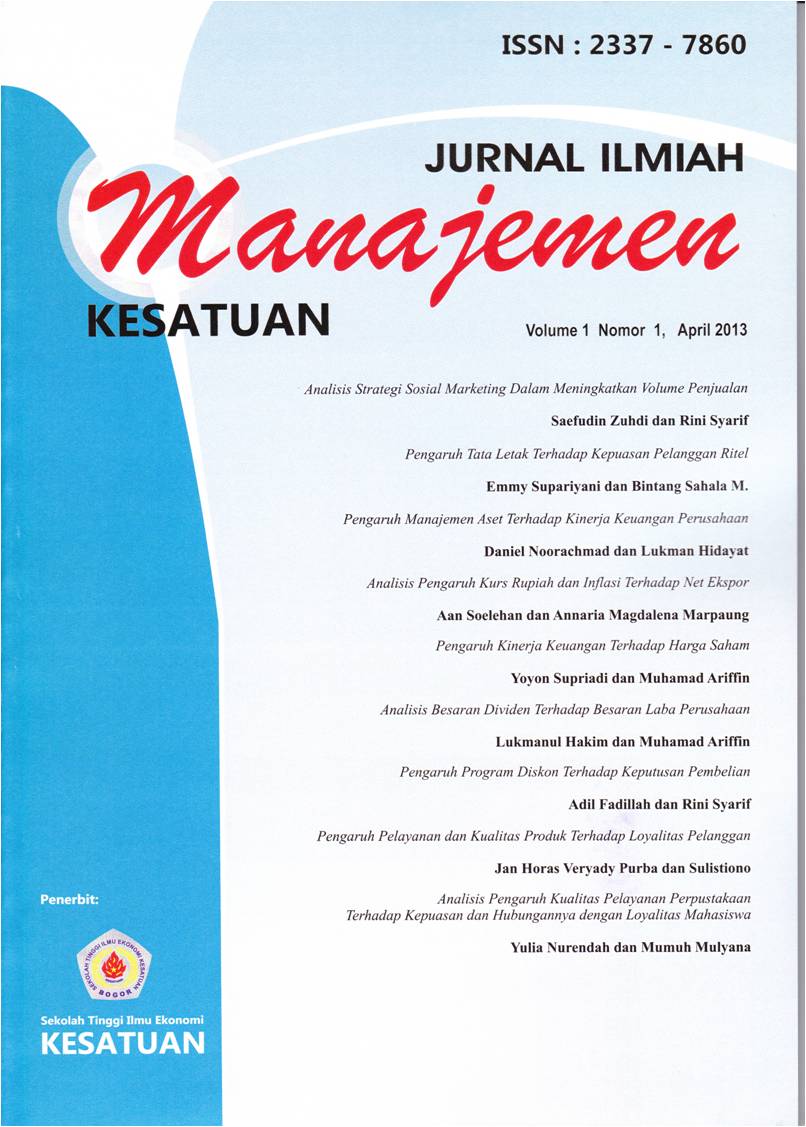Analyzing Quality of Human Resources and Risk-Taking in the Performance of Creative Industry MSMEs in Tabanan Regency
DOI:
https://doi.org/10.37641/jimkes.v11i2.2079Keywords:
Human Resources, Risk Taking, MSME Performance, Creative Industries, BaliAbstract
Bali possesses significant potential for production and trade within the Micro, Small, and Medium Enterprises (MSMEs) industrial sector, in addition to its tourism. This study aims to analyze the impact of quality of human resource factors and risk-taking behavior on the performance of MSMEs in the creative industries of the Tabanan district, using the resource-based view model concept. The research employs a quantitative method, including a questionnaire, with a sample of 54 MSMEs. Data processing is conducted using SPSS version 24, and three hypotheses are tested. The research findings indicate that the quality of human resources significantly enhance creative industry performance, and the risk-taking also contributes positively to creative industry performance. Furthermore, the quality of human resources significantly influence risk-taking. These results underscore the substantial and dominant implications of both the quality of human resources and risk-taking variables on the performance of creative industry MSMEs.
ABSTRAK
Bali memiliki potensi yang signifikan untuk produksi dan perdagangan dalam sektor industri Usaha Mikro, Kecil, dan Menengah (UMKM), selain dari sektor pariwisatanya. Penelitian ini bertujuan untuk menganalisis dampak faktor sumber daya manusia dan perilaku mengambil risiko terhadap kinerja UMKM di industri kreatif kabupaten Tabanan, dengan menggunakan konsep model berbasis sumber daya. Penelitian ini menggunakan metode kuantitatif, termasuk kuesioner, dengan sampel sebanyak 54 UMKM. Pengolahan data dilakukan menggunakan SPSS versi 24, dan tiga hipotesis diuji. Temuan penelitian menunjukkan bahwa sumber daya manusia secara signifikan meningkatkan kinerja industri kreatif, dan pengambilan risiko juga memberikan kontribusi positif terhadap kinerja industri kreatif. Selain itu, sumber daya manusia secara signifikan memengaruhi pengambilan risiko. Hasil ini menekankan implikasi yang signifikan dan dominan dari kedua variabel sumber daya manusia dan pengambilan risiko terhadap kinerja UMKM di industri kreatif.
Kata kunci: Sumber Daya Manusia, Pengambilan Risiko, Kinerja UMKM, Industri Kreatif, Bali
Downloads
References
Albrecht, S., Breidahl, E., & Marty, A. (2018). Organizational resources, organizational engagement climate, and employee engagement. Career Development International, 23(1), 67-85.
Barney, J. (1991). Firm resources and sustained competitive advantage. Journal of management, 17(1), 99-120.
Becker, B. E., & Huselid, M. A. (1998). Human resources strategies, complementarities, and firm performance. SUNY Buffalo: Unpublished manuscript.
Brown, T. C., O’Kane, P., Mazumdar, B., & McCracken, M. (2019). Performance management: A scoping review of the literature and an agenda for future research. Human Resource Development Review, 18(1), 47-82.
Castanias, R. P., & Helfat, C. E. (1992). Managerial and windfall rents in the market for corporate control. Journal of Economic Behavior and Organization https://doi.org/10.1016/0167-2681(92)90025-7
Fey, C. F., & Björkman, I. (2017). The effect of human resource management practices on MNC subsidiary performance in Russia. Human Resource Management in Russia, 307-330.
Gruman, J. A., & Saks, A. M. (2011). Performance management and employee engagement. Human resource management review, 21(2), 123-136.
Karimi, S., Holland, C. P., & Papamichail, K. N. (2018). The impact of consumer archetypes on online purchase decision-making processes and outcomes: A behavioural process perspective. Journal of Business Research, 91, 71-82.
Koeswahyono, I., Maharani, D. P., & Liemanto, A. (2022). Legal breakthrough of the Indonesian job creation law for ease, protection, and empowerment of MSMEs during the COVID-19 pandemic. Cogent Social Sciences, 8(1), 2084895.
Kwon, D. B. (2009, October). Human capital and its measurement. In The 3rd OECD world forum on “statistics, knowledge and policy” charting progress, building visions, improving life (pp. 27-30).
Litwin, M. S., & Fink, A. (1995). How to measure survey reliability and validity (Vol. 7). Sage.
Lyng, S. (2014). Action and edgework: Risk taking and reflexivity in late modernity. European Journal of Social Theory, 17(4), 443-460.
Miller, D., & Friesen, P. H. (1983). Strategy-making and environment: The third link. Strategic Management Journal, 4, 221-235.
Mollah, S., Hassan, M. K., Al Farooque, O., & Mobarek, A. (2017). The governance, risk-taking, and performance of Islamic banks. Journal of financial services research, 51, 195-219.
Peccei, R., & Van De Voorde, K. (2019). Human resource management–well‐being–performance research revisited: Past, present, and future. Human resource management journal, 29(4), 539-563.
Rosa, P., Carter, S., & Hamilton, D. (1996). Gender as a determinant of small business performance: Insights from a British study. Small business economics, 8, 463-478.
Singh, P. K. (2012). Management of Business Processes Can Help an Organization Achieve Competitive Advantage. International Management Review, 8(2).
Singh, S. K., Gupta, S., Busso, D., & Kamboj, S. (2021). Top management knowledge value, knowledge sharing practices, open innovation and organizational performance. Journal of Business Research, 128, 788-798.
Sugiyono, P. D. (2013). Metode penelitian manajemen. Bandung: Alfabeta, CV.
Tambunan, T. (2019). Recent evidence of the development of micro, small and medium enterprises in Indonesia. Journal of Global Entrepreneurship Research, 9(1), 18.
Tan, E. (2014). Human capital theory: A holistic criticism. Review of educational research, 84(3), 411-445.
Tsang, A. H., Jardine, A. K., & Kolodny, H. (1999). Measuring maintenance performance: a holistic approach. International Journal of Operations & Production Management, 19(7), 691-715.
Wang, W. Y., & Chang, C. (2005). Intellectual capital and performance in causal models. Evidence from the information technology industry in Taiwan. Journal of Intellectual Capital, 6(2), 222–236. https://doi.org/10.1108/1469193
Wright, P. M., McMahan, G. C., & McWilliams, A. (1994). Human resources and sustained competitive advantage: a resource-based perspective. International journal of human resource management, 5(2), 301-326.
Downloads
Published
How to Cite
Issue
Section
License
Copyright (c) 2023 Author(s)

This work is licensed under a Creative Commons Attribution-ShareAlike 4.0 International License.




